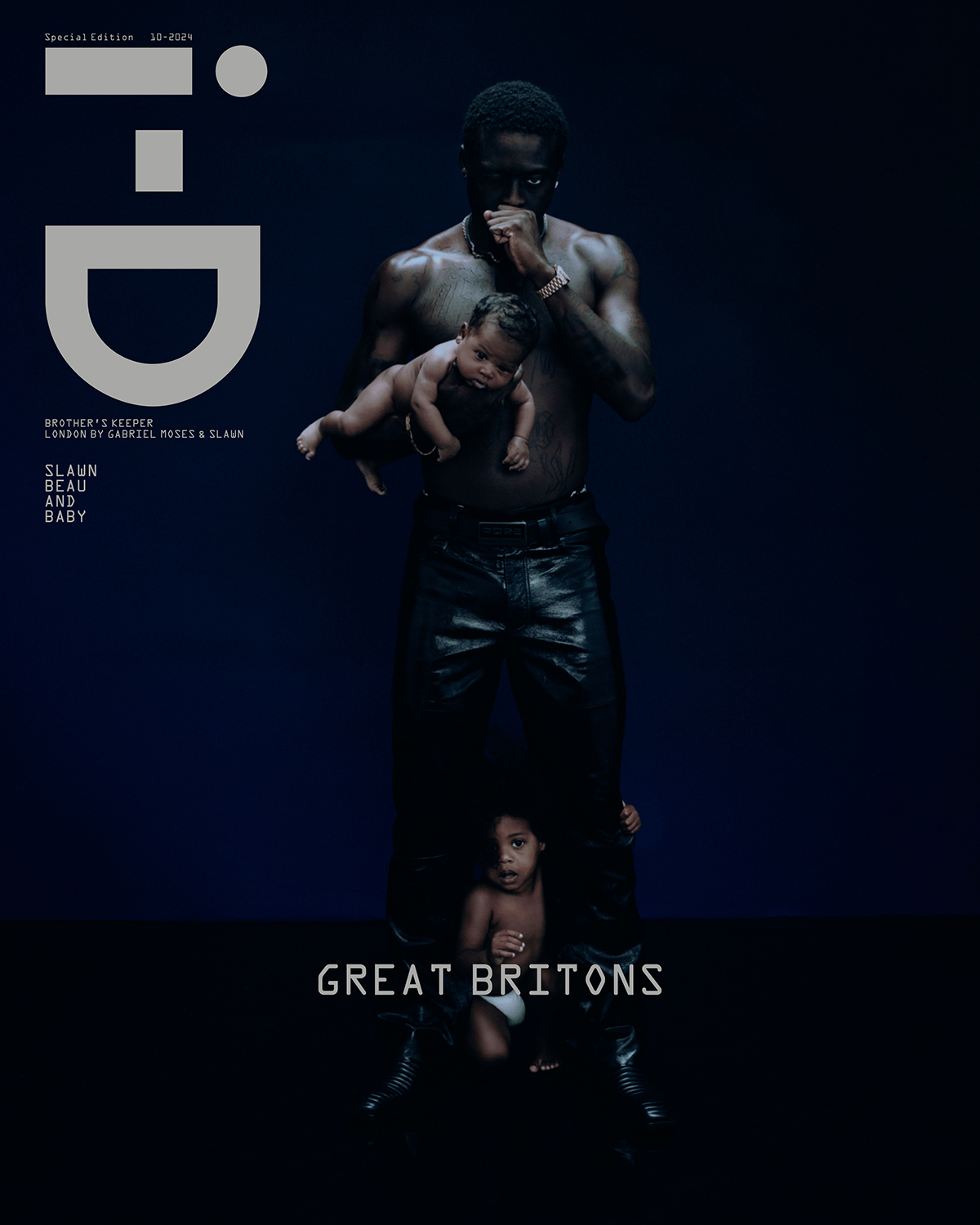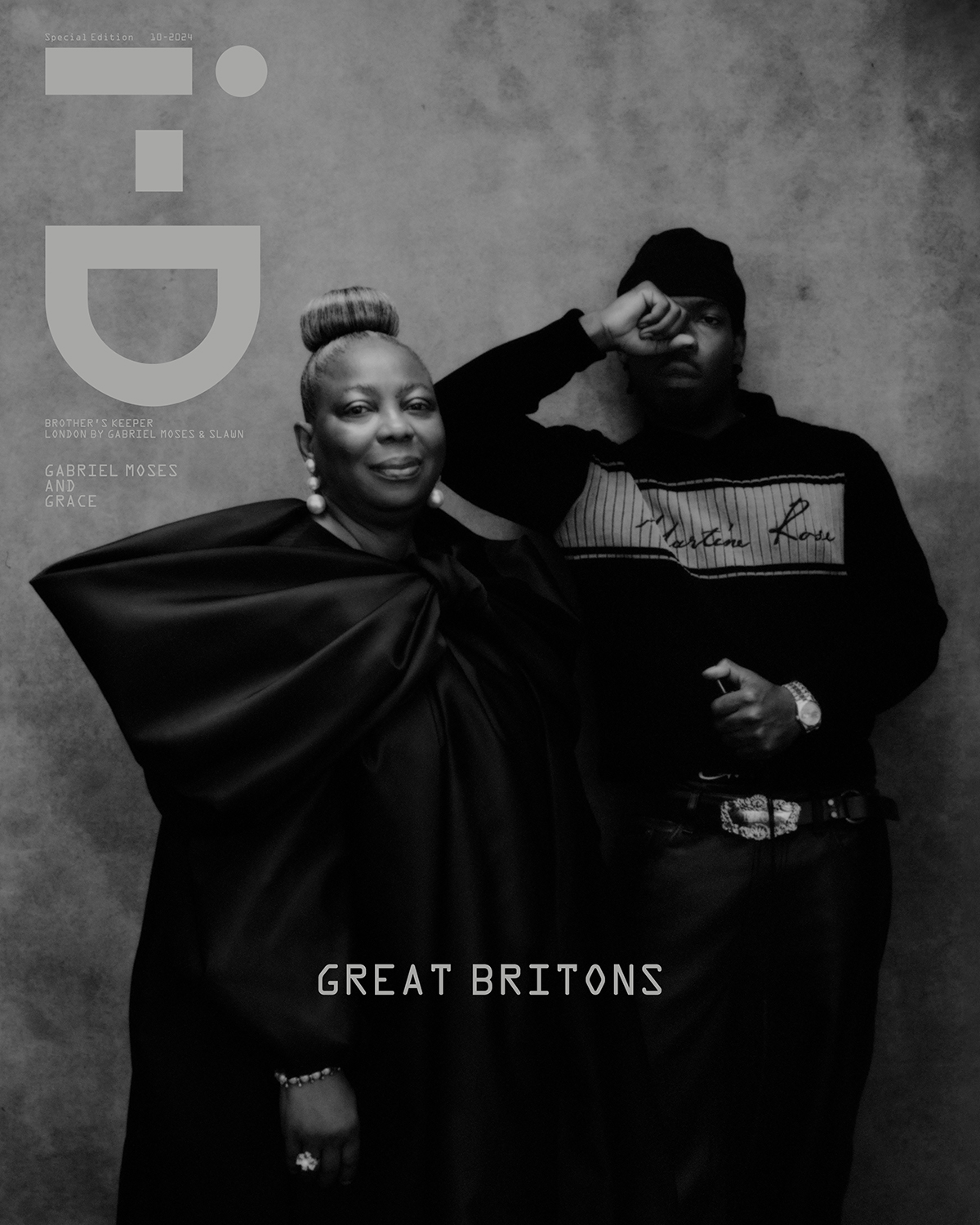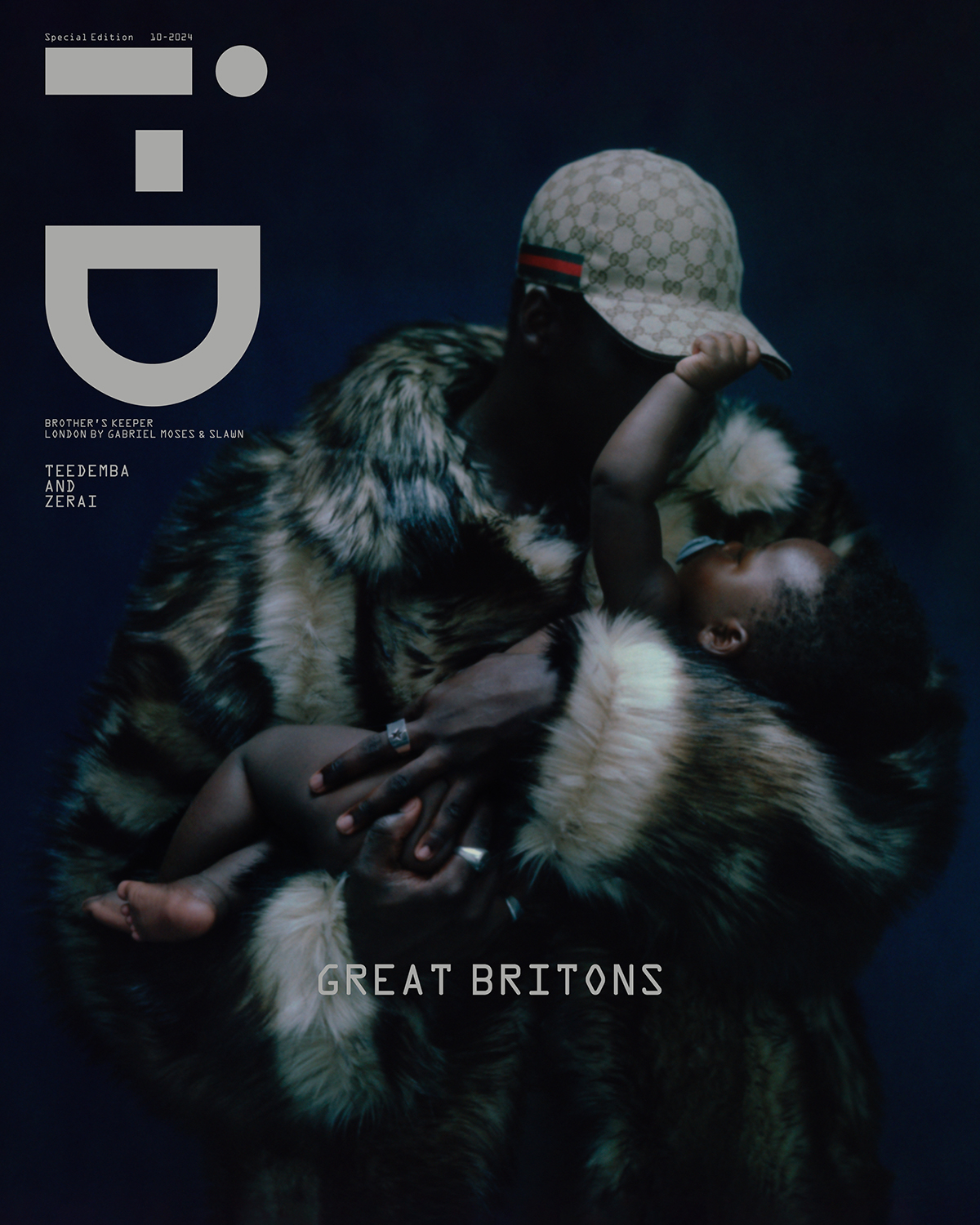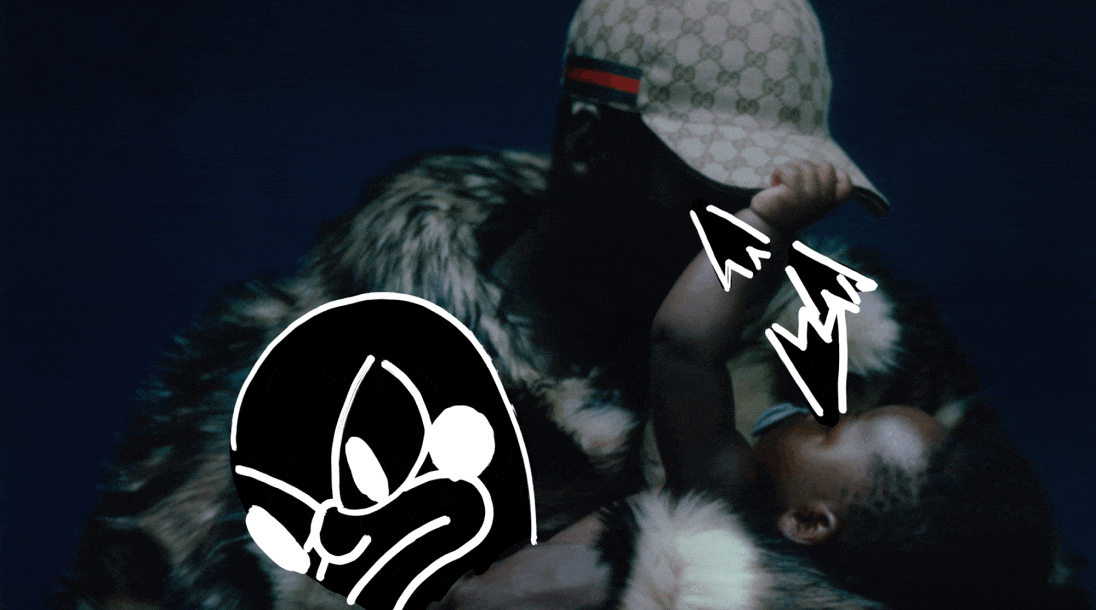This story is taken from Brothers’ Keeper, a special edition of i-D by Slawn and Gabriel Moses. Buy your copy here.
When a car exploded on Alexander McQueen’s catwalk in 1997 — a mishap rather than a fashion week stunt — Alek Wek was backstage fiddling with her contacts. “I couldn’t put them in, my eyes were watering.” McQueen, frazzled and manic, caught her fussing and said “Alek Wek, you don’t need no contact lens – let’s go!” She was promptly sent down the runway, wearing a gold Dzila and a coat with horned shoulders. “I wore my own G-string!” Wek recalls over the phone from her home in New York.
She remembers the show fondly – the scowling, moody, grunge theme of the catwalk, the fierceness of a London comeback, the sounds of 90s tribal house, “I love The Prodigy, you know,” she says. “Like, ‘I’m a firestarter?’ Massive! London calling, let’s go!” It’s just one of the many historic fashion moments that Wek was caught up in during her 90s ascent, when she rose to become one of her generation’s defining supermodels, consecrated by the admiration and devotion of myriad designers, photographers, entertainers and magazines. In 1997, i-D named her model of the decade.
Wek’s distinctiveness and allure of course came from her look. By the time Wek arrived in London as a refugee from South Sudan in 1991, Black supermodels like Naomi Campbell, Grace Jones, and Iman had long established a pretext for Black women’s presence on catwalks, but as an African model with Dinka features, Wek established her own iconography. For her, it’s always been about craft. That premise informed her first i-D cover, shot by Mark Mattock in 1998. “The experience was so beautiful and simple, they really celebrated my coming of age and acknowledged my art and love of art,” she says.
Her second cover, in 2000, shot by Richard Burbridge and styled by Edward Enninful, however, “acknowledged the coming of age of the many aspects of the fashion industry and design,” signalling just how much Wek, and the industry, had transformed each other. Over two decades after those first shoots, Wek is back on the cover of i-D, this time shot by Gabriel Moses. “It’s another coming of age moment and a celebration of the arts and the creative industries. Everybody loves Gabriel’s work. It was such a huge moment and I have added more iconic i-D memories to my career. Alek Wek – i-D – third time – the best is yet to come!”
Moses, who grew up seeing images of Black models on his fashion student sister’s bedroom walls, felt the gravity of that back catalogue and iconography distilled into Wek’s very presence. “On the day of the shoot, I was saying, ‘Oh my goodness, I’m really shooting the reference!’” he says. If anything, it’s proof that Wek’s incredible accomplishments are still coming. Here, Wek discusses her career, one which shows no signs of slowing down.


Gabriel Moses described his shoot with you as “a moment” and spoke of a great energy between the two of you. How did you feel about being shot by him?
I love being able to work with new photographers that I’ve never worked with, and this was my first time working with Gabriel. I’d heard such amazing things about him — I trust my folks and they were spot on because there were magical moments, and I can’t wait to see it. When I’m on set I refrain from looking at the computers, because I really want to be one-on-one with what’s going on. You never get that time back! So if you make the best of it, it can be really incredible. I really want to work with more of the up-and-coming and folks I’ve never worked with before. Gabriel was like, “Did [you] ever work with Jean-Paul Goude?” And I’m like, “No! But I love his work.” And it’s not too late, that’s the exciting part about my journey.
“The embrace of my community inspired me to be comfortable with what I really love. I didn’t have to do something only because it’s going to make me money.”
Let’s get into that journey. You say that your love of fashion is informed by your love of art — where did that appreciation for art begin?
After I came to London in 1991 I realised there was a Sudanese community — that’s grown so much now — and they celebrated art. That’s where my love of art flourished. They embraced the arts right from when I was at secondary school in Hackney. That community embrace inspired me to be comfortable with what I really love. I didn’t have to do something only because it was going to make me money. As a girl I always loved fashion and art, at school I loved my dungarees and my Dr. Martens. But it’s how much it was embraced that made a difference. From a young age I was watching my aunties, and I remember my aunties loved me for who I am. That’s one thing I would say to young people now: it’s okay to be yourself, to love what you love, even though sometimes you’re not quite sure. Listen to your intuition and who you are. Those are the things that really helped me from a young age, knowing that I had my own particular style but also that I needed to be in an environment that embraced and nurtured it. In secondary school, I didn’t get grade As but my highest grade was art. So it goes to show you that it was one of my favourite subjects!

How did you make that first step into modelling?
When I was at London College of Fashion in 1995 [studying fashion business and technology] I met a friend who took me to the park where I was discovered to be a model by Fiona Ellis. I was quickly cast in a Tina Turner music video [for “Goldeneye”] and they wanted me to swim but I couldn’t swim. I still can barely swim, it’s embarrassing — but I’m taking lessons — so I just did the part on a chaise longue. The other girl was in the tank swimming and I was like, Oh my God, that’s amazing, I want to be able to do that one day. And then I was in Janet Jackson’s “Got ‘Til It’s Gone” video, and that’s just part of history. I remember growing up knowing Michael Jackson’s music, “Thriller”; my older brothers and sisters knew it back in South Sudan. And Busta Rhymes! The video for “Put Your Hands Where My Eyes Could See” — I still do my dance for that sound.
You walked some incredible catwalks and have shot some amazing campaigns too. What have been the real highlights for you?
God, there’s so many shows that I’ve had really emotional moments with. Being the first African bride for Chanel with Karl Lagerfeld and walking through the garden and him saying “Alek! You’re a star!” Just like… Woah. But I know what he meant now. I’d worked up to that moment, and that was before social media so he respected that. This is somebody that speaks seven languages. I only speak three; Arabic, Dinka and English!
Herb Ritts — shooting Pirelli with him. Irving Penn. Going to Japan for the first time with Issey Miyake — I used to see it in newspapers. Shooting with Nick Knight, my first British Vogue editorial and doing Pirelli with him. Peter Lindbergh, what a sweetheart, what an amazing guy. God the list can go on. Yves Saint Laurent; I became his muse in 2001 and worked with him and that house every year. Every season he knew the girls he wanted, and there was such a respectful embrace of womanhood in his team. Gucci with Tom Ford at the time. Opening Donna Karan — what a woman, her whole zen I love. And I’ve finally just done L’Oréal in Paris. I’ve always wanted to work with L’Oréal because I love oils; my parents always had homemade sandalwood oils. I’m a big fan, I love what they stand for.












Was there a point that you realised you had not only made it as a model but were one of the biggest names in fashion?
When I realised I can just be Alek. Not Alek Wek, the daughter of my parents. Not Alek Wek, the former refugee from South Sudan. Just Alek. I’m out now. And I’m growing. I can be anxious, I can be a little shy, that’s okay. But I can be me as a whole. And I’ve still got more growth to do. And now being a woman and growing more into my womanhood is so beautiful.
“Growing more into my womanhood is so beautiful. I would tell any young person it’s okay to be yourself. Today is a different day, tomorrow is going to be different.”
What did you learn about yourself during the process of writing your book, Alek, in 2007? Do you have plans to write another?
I learned so much. It’s okay to be uncomfortable. Just because I’ve been in the industry for so long doesn’t mean you don’t have any time or room for learning. For me there’s so much more to write about now that I’m in my womanhood and settling in, and I want to settle down too. It’s even more exciting. I’m editing my archives now and looking at Annie Leibovitz, the calendars we did, the images, all these things that they’ve given to me throughout the years. It really humbles me now because I’m seeing things I didn’t realise before, because I was just being who I was as a young lady and now a woman. So this is the beginning.


You’ve done, and continue to do, incredible, important work with the UN, Doctors Without Borders, Unicef and many others. There are still many people fleeing wars and in fact more than ever before — there was a 12% increase in 2023, from UN figures. How do you hope your story might inspire others who have recently been forced to flee their homes and families?
I wouldn’t want anyone to go through what I went through, but also I’m a survivor. I’m not a victim. So I’m coming from a place where I know what that feels like. Right now there are a lot of refugees displaced. People need food, shelter and water. If we were more mindful of that in fashion, if we could have empathy, we have such an amazing platform and a voice to shed light on it and we could go a long way. So I try and do the best that I can just by being myself, and I hope I can empower others to feel like they can accomplish so much.
Is there one thing, above all, that you feel particularly proud of?
I feel proud of the fact that I’ve helped people shift their judgements on the way a model can look, to give other people a chance and embrace diversity. Because back then, you wouldn’t see many women who look like me doing not just commercial but high fashion. So I’m glad I’ve played my part in that area, and I’m glad that I haven’t been shy to embrace others that came before and and after me. I give them homage, and I think that’s what’s beautiful. And it comes full circle. That’s why I’m still working with Yves Saint Laurent, and as I said, finally I got to work with L’Oréal, which embraces strong women. I was so touched and humbled by that.
Credits
Photography: Gabriel Moses
Artwork: Slawn
i-D Global Creative Direction: Jamie Reid
Fashion: Gerry O’Kane
Hair: Kim Rance at Management Artists
Make-up: Mata Mariélle at The Wall Group
Nail Technician: Edyta Betka using OPI
Set Design: Julia Dias
Movement Director: Manu Loca
Photography Assistance: Darren Karl-Smith and Jack Savage
Digital Technician: Ben Quinton
Styling Assistance: Anna Sweasey
Tailor: Della George
Hair Assistance: Jade Hartley and Sara Asunramu
Set Design Assistance: Sam Edyn, Isaac Ashley, Matthew Payne, Ellen Forbes Scenic and Ferg Lockyear
Production: Liberty Dye And Victoria Mancisidor at Concrete Rep Ltd, Thea Charlesworth at theArcade Production
Production Manager: Jeremy Rwakasiisi
Production Assistance: Kate Roswell
Retouching: The Hand Of God
Casting Director Isabel Bush at Concrete Rep Ltd
Special Thanks: Grace Rotimi and Cassia Agyeman
Model: Alek Wek at Storm













